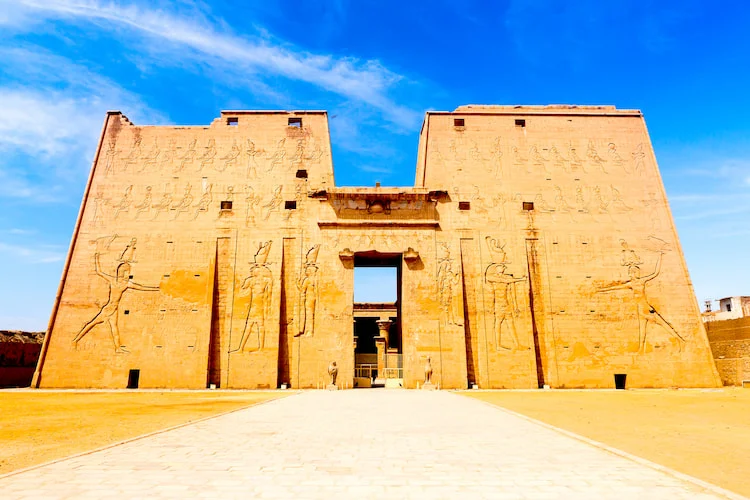

The Temple of Horus in Edfu
The Temple of Horus in Edfu: A Jewel of Ancient Egyptian Architecture
Introduction: A Journey into the Past
Imagine traveling along the Nile when suddenly a massive temple rises from the desert sand before you. Its massive pylons reach into the blue sky, and mysterious hieroglyphs cover the walls. Welcome to the Temple of Horus in Edfu, one of the best-preserved temples of ancient Egypt!
The History of the Temple: A Building for Eternity
The Temple of Edfu wasn’t built overnight. Its history spans nearly two centuries:
- Construction began: 237 BC under Ptolemy III
- Completion: 57 BC under Ptolemy XII
- Total construction time: 180 years!
Imagine the generations of workers and craftsmen who dedicated their lives to this project. Fathers teaching their sons the trade as the temple slowly grew in height.
Architecture: A Masterpiece of the Ptolemaic Period
The Temple of Edfu is not just big, it’s gigantic:
- Length: 137 meters
- Width: 79 meters
- Height of the pylons: 36 meters
The Layout of the Temple:
- The Great Pylon: A massive entrance gate, decorated with reliefs of the Pharaoh defeating Egypt’s enemies.
- The Forecourt: An open courtyard surrounded by columns. People gathered here for festivals and ceremonies.
- The Hypostyle Hall: A forest of stone columns, their capitals adorned with plant ornaments.
- The Sanctuary: The heart of the temple, where the statue of Horus was kept.
Every room in the temple tells a story, every relief has a meaning. It’s like walking through a three-dimensional history book!
The Significance of Horus: The Falcon God
Horus, the god with the falcon head, was one of the most important deities in ancient Egypt:
- Son of Isis and Osiris
- Protective god of the Pharaoh
- Symbol of the sky and royal power
In the Temple of Edfu, Horus was worshipped in his local form as Horus of Behdet.
Life in the Temple of horus : More Than Just a Place of Worship
The temple was not only a religious center but a vibrant organism:
- Priests performed daily rituals to honor the gods
- Scribes documented important events and managed the temple’s property
- Craftsmen constantly worked on maintaining and beautifying the temple
- Pilgrims came from far and wide to bring offerings and ask for divine assistance
Imagine the scent of incense wafting through the halls and the murmur of prayers echoing off the walls.
The Mysteries of Edfu: Festivals and Rituals
The temple was the scene of important religious festivals:
- Festival of Beautiful Union: Hathor, the goddess of love, annually visited Horus in Edfu
- Coronation Festival: The divine rule of Horus was renewed annually
- Victory-over-Seth Festival: The mythical triumph of Horus over his uncle Seth was reenacted
These festivals were not just religious events but also great public celebrations with music, dance, and feasts.
The Walls Speak: Inscriptions and Reliefs
One of the most fascinating features of the Temple of Edfu are its walls. They are covered with hieroglyphs and reliefs that give us a unique insight into ancient Egyptian culture:
- Mythological scenes telling the stories of the gods
- Ritual texts detailing the temple ceremonies
- Historical inscriptions reporting the deeds of the Pharaohs
- Medical and astronomical texts
It’s as if the ancient Egyptians left a huge stone library for posterity!
The Temple Through the Ages: From Antiquity to Today
The Temple of Edfu has a turbulent history:
- In Roman times, it remained an important religious center
- With the rise of Christianity, it was abandoned and fell into disrepair
- Sand and debris covered it for centuries
- In the 19th century, it was rediscovered and excavated
Today, the Temple of Edfu is one of the best-preserved ancient temples in Egypt and a popular tourist destination.
The Temple Today: A Window into the Past
For visitors, the Temple of H is an overwhelming experience:
- The sheer size of the complex impresses every visitor
- The detailed reliefs provide insights into ancient Egyptian culture
- The well-preserved color remnants hint at how splendid the temple must have once looked
Many visitors report a sense of awe as they walk through the ancient halls.
Conclusion: A Timeless Testimony to Human Achievement
The Temple of Horus in Edfu is more than just an old building. It is a testament to human creativity, dedication, and spirituality. It reminds us that people of all times strived to create something greater than themselves.
When you visit the temple or see pictures of it, remember: Every stone was worked by human hands, every relief carefully chiseled. Behind the monumental facade are the stories of countless people – priests, craftsmen, pilgrims – who all contributed their part to creating and preserving this wonder.
The Temple of Edfu invites us to connect with our ancestors across the boundaries of time and culture. It reminds us that we too are part of a long chain of human achievements. And who knows? Maybe it inspires us to create something ourselves that will stand the test of time.
Recent Posts
Edfu Temple :5 Reasons to Explore the Majestic Today
Discover 7 Amazing Features of Sinbad Hotel Egypt for 2024
Top 7 Reasons to choose Egypt Air Hospital in Egypt
All Categories
Tags


Thailand







